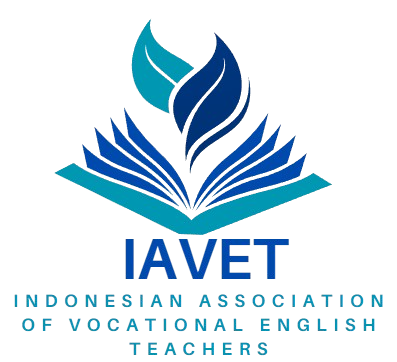Effective Reading Instruction in ESP: Practical Approaches to Improving Vocational Students Content-Area Reading Comprehension
DOI:
https://doi.org/10.31963/rial-ej.v1i1.3748Abstract
Effective reading instruction in Vocational Higher Education (henceforth VHE) has been criticized as ineffective, as demonstrated by poor reading test results, indicating a deficient students’ reading performance. This article examines and gains insight into the reasons why things occur as they do by discussing the following four topics: (1) describing the context in which reading instruction occurs and why this instructional effort does not work as expected; (2) describing the nature of content area reading; (3) unpacking things that could potentially encourage students’ interests and increase their reading involvement, thereby making their reading more effective; and (4) proposing a set of pedagogical principles that could potentially improve the students optimal reading and comprehensionReferences
Alwasilah, A.C. 2004. Perspektif Pendidikan Bahasa Inggris di Indonesia dalam Konteks Persaingan Global. Cetakan Kedua. Bandung: C.V. Andira.
Ambruster, B.B, Anderson, T.H. dan Ostertag, J. 1987. “Does Text Structure Summarization Instruction Facilitate Learning from Expository Text?†Reading Research Quarterly. 22. 331 – 346.
Bell, L. dan Lee, C. L. 2005. “Using Reading in Content Area Strategies to Improve Student Understanding in Family and Consumer Sciencesâ€. Journal of Family and Customer Science Education [Online] Vol.23.(2) 1-7
Carnine, D., Silbert, J., and Kamenui, E.J. 1990 Direct Instruction Reading. Columbus: Merrill Publishing Company.
Collins dan Decker, N. 1994. Metacognition and Reading to Learn, ERIC Identifier: ED376427 Tersedia: http://www.vtaid.com/prog/ERIC/Read-to-Learn.htm. [9 May 2010]
El-Koumy, A.K 2004. Metacognition and Reading Comprehension: Current Trends in Theory and Research. [online] Tersedia: http://www.eric.ed.gov/contentdeliver /service/ERICservlet/accno=ED490569 .[1 January, 2010].
Farrel, T.S.C. 2003. Planning Lesson for a Reading Class. Portfolio Seri 6. Singapore: SEAMEO Regional Language Centre.
Gambrell, Morrow, dan Pressley. 2007. Best Practices in Literacy Instruction (3rd. Ed.). The Guilford Press: New York.
Gerlach, V..S dan Ely, D. P. 1980. Teaching and Media: a Systematic Approach London: Prentide Hall. Inc.
Grabe, W. 1991. “Current Developments in Second Language Reading Research.†TESOL Quarterly, 25 (3) , 375-406.
Grabe. W. and Stoller. F.L 2002. Teaching and Searching Reading. London: Harlow
Guthrie, J.T., dan Wigfield, A. 2000. Engagement and Motivation in Reading, [Online] Dalam Handbook of Reading Research, Vol. III Kamil, et al. (Eds). Lawrence Erlbaum Associates: Mahwah,NJ. Tersedia: http://www.geogle.com.books?hl=id&Ir=&id=uv-r5kH1.[23 Mei 2010]
Guthrie, J.T. 2010. Summer: 2010/Engagement [Online]. Tersedia: http://red677.pbworks.com/w/page/8522639/engagement [12 Desember 2010]
Guthrie, J.T. dan Davis, M.H. 2003. Motivating Stratuggling Readers in Middle School Through an Engagement Model of Classroom Practice. Dalam Reading and Writing Quarterly [Online]. Vol. 19. 24 halaman Tersedia: http://www/2.csdm.qc.ca/SaintEmiolie/bernett/annexes/ASS6826/Guthrie Davis 2003.pdf. [10 Oktober 2010]
Hall, L.A. 2005. Teachers and Content Area Reading: Attitudes, Beliefs and Change. Dalam Teaching and Teacher Education [Online] Vol. 21. 12 halaman. Tersedia: http:www//elsevier.com/locate/tate. [11 November 2010]
Herbert, L. 1965. The Structure of Technical English. London: Longman.
Israel, S.E. 2007. Metacognively Thinking: From Using Metacognitive Assessment to Create Individualized Reading Instruction dalam International Reading Association.
Iwahori, Yurika. 2008. Developing Reading Fluency: A Study of Extensive Reading in EFL. Dalam .Reading in a Foreign Language. [Online] Vol. 20 (1), 21 halaman. Tersedia: http://nflrc.hawaii.edu.tfl
Kamil, M.L. 2003. Adolecents and Literacy: Reading for the 21st Century. [Online] Washington, DC: Alliance for Excellent Education. Tersedia: http://www.all4ed.org/publications/AdolescentsAndliteracy.pdf.[20Maret 2009]
Komiyama, R. 2005. Concept-Oriented Reading Instruction: Engaging Classroom, Lifelong Learners. Dalam Reading in a Foreign Language Journal. [Online] 17 (1) Tersedia: http:..www://nflrc.hawaii.edu/rfl. [12 Desember 2010]
McKenna,M.C., dan Robinson, R.D 1993. Teaching Through Text: A Content LiteracyApproach to Content AreaReading.White Plains, New York: Longman.
Musthafa, B. 2011. Promoting Adolecent Literacy: What Language Teachers Should Know and Be able To Do. Educationist: Vol. V (1) 16 - 21
Musthafa, B. 1996. “Learning From Texts and Reading Instruction,†EDRS. The Educational Resources Information Center (ERIC)
Pang et al. 2007. Teaching Reading: Educational Practices Seri 12.: Washington DC: The International Bureau of Education IBF.
Pearson, D. at al. 2010. Capitalizing on Context: Curriculum Integration in Career and Technical Education. A Join Report of the NRCCTE Curriculum Integration Workgroup. National Research Center for Career and Technical Education. Louisville KY: University of Louisville.
Tampubolon, DP. 1987. Kemampuan Membaca: Teknik Membaca Efektif dan Efisien. Bandung: Penerbit Angkasa
Torgesen, J.K. 2007. Five Areas of Instructional Improvement to Increase Academic Literacy.[Online] AdLit.Org.Adolescent Literacy.Tersedia: http://www/google.co.id.search [19 Januari 2011]
UPT. Bahasa. 2012. Data Hasil TOEFL Mahasiswa. Makassar: PNUP.
UPT. Hubungan Industri. 2012. Data Rekruitmen Alumni. Makassar: PNUP.
Vacca, Richard T., Vacca Jo Anne L. 1993. Content Area Reading (fourth ed.). New York: Harper Collins-College publisher
Wiriyachitra, A. dan Apichatrakul, C. 1984. “How to Read Scientific English and Technical English Understandingly.†English Teaching Forum, 12 (10) 17 – 29.
Downloads
Published
Issue
Section
License
Copyright (c) 2022 Research and Innovation in Applied Linguistics-Electronic Journal

This work is licensed under a Creative Commons Attribution-ShareAlike 4.0 International License.
Authors who publish with this journal agree to the following terms:
Authors who submit article to this journal, agree to grant the copyright to Research and Innovation in Applied Linguistics (RIAL) under a Creative Commons Attribution License: Creative Commons Attribution-ShareAlike 4.0 International License.
![]()
For collaborative works, authors should ensure that they have secured the necessary permissions from co-authors to submit the manuscript and grant the rights outlined in this policy.
Archiving and Access:
RIAL upholds an open access policy, ensuring that articles are freely accessible to a global audience upon publication. Authors' work will be archived electronically, facilitating its long-term availability and visibility.







.png)
